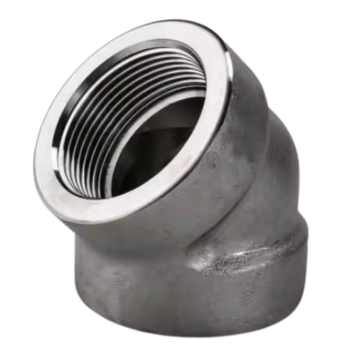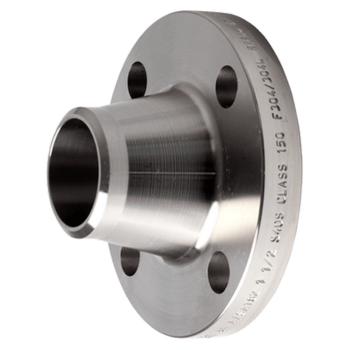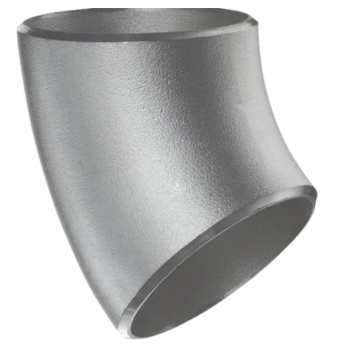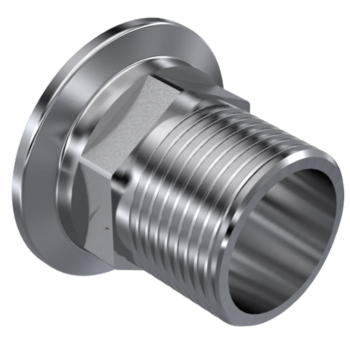Spectacle Blind Flanges Suppliers
ASME B16.48 Figure 8 Plate

ASME B16.48 Spectacle Blind Flanges: Dimensions | Specifications | Material Grade | Standards | About Figure 8 Flange | All Product Types
Spectacle Blind Flanges, also known as Figure-8 Blinds, are specialized piping components designed for permanent or long-term isolation of a pipe section. These flanges consist of a solid disk (blind) and an open ring (spacer) connected by a tie-bar. The assembly is rotated to either block the flow (blind side) or allow it (spacer side), offering a simple mechanical solution for shut-off and maintenance without removing the entire flange setup.
Manufactured in accordance with ASME B16.48 or MSS-SP-96, spectacle blind flanges are widely used in pipelines where frequent flow isolation is not required, but system safety is critical. These are typically installed between two standard flanges and bolted in place. Their application ensures operational safety during inspections, repairs, or when sections of the pipeline need to be isolated.
We supply spectacle blind flanges in a wide range of materials such as Stainless Steel (304/304L, 316/316L), Carbon Steel (A105, A516 Gr.70), Alloy Steel (F5, F9, F11, F22), and Duplex & Super Duplex (UNS S31803, S32750). Sizes range from ½″ to 60″ NB, with pressure ratings up to Class 900 (PN160). Surface finishes are available in stock finish or custom-machined as per client drawings or project requirements.
These flanges are commonly used in refineries, chemical processing units, power plants, offshore drilling, and shipbuilding industries. Their reliable sealing, easy operation, and high durability make them essential for critical flow control systems. As a leading spectacle blind flange manufacturer and exporter from India, we ensure international standards, fast delivery, and complete certification support with every supply.
ASME B16.48 Spectacle Blind Flanges Manufacturer in Stainless Steel, Carbon Steel, Duplex – Figure 8 Plate Flanges for Permanent Pipeline Isolation
For complete technical details, including dimensions, pressure rating classes, weight charts, sizes, tolerances, and material specifications of our ANSI B16.48 Figure 8 Flange, please download the full Catalog PDF below.
Spectacle Blind & Figure-8 Flanges with Raised Face / RTJ – Size Range ½″ to 24″ – Pressure Class 150 to 900 – Designed for Flow Control and Maintenance Isolation
Technical Specifications of Spectacle Blind Flange
| Specification | Details |
|---|---|
| Type | Spectacle Blind Flange (Figure-8 Blank) |
| Design Standard | ASME B16.48 |
| Size Range | ½″ NB to 60″ NB (DN15 to DN1500) |
| Pressure Ratings | Class 150, 300, 600, 900, 1500 |
| Face Type | Raised Face (RF), Flat Face (FF), Ring Type Joint (RTJ) |
| Types | Spectacle Blind, Paddle Spacer (Spade), Paddle Blind |
| Thickness | As per pressure rating and pipe schedule |
| Manufacturing Type | Plate-cut and machined, waterjet or plasma-cut |
| Application | Isolation of piping sections, pressure testing, maintenance shutdowns |
| Standard Compliance | ASME B16.48, ANSI B16.5 (for companion flanges), NACE MR0175 (on request) |
| Dimensions | As per ASME B16.48 Table 1–7 (including outer diameter, web, bore, bridge) |
| Finish | Black Painted, Rust-Proof Oil, Epoxy Coated, Galvanized |
| Testing & Inspection | PMI, Hydro Testing (for system), Visual, Dimensional, NDT |
| Packaging | Export standard seaworthy wooden cases or pallets |
| Certification | EN 10204 Type 3.1 / 3.2, IBR Approval, ISO 9001, PED 2014/68/EU, NACE MR0175 / ISO 15156, ISO 9001 |
| Application Industries | Oil & Gas, Petrochemical, Power Generation, Water Treatment, Food & Beverage, Fire Protection Systems, Pulp & Paper, Shipbuilding, HVAC, Offshore |
| Origin | Made in India (by Nutech Overseas) |
| Export Network | USA, Europe, and Middle East |
Complete Material Grade Chart - Class 150 Figure 8 Flange
| Material Category | Spectacle Plate Flange Grades |
|---|---|
| Stainless Steel Figure 8 Flange | ASTM A182 F304 / F304L / F304H, F316 / F316L / F316Ti, F310, F309S, F317 / F317L, F321 / F321H, F347 / F347H, F904L, ASTM A351 CF3 / CF3M / CF8 / CF8M / CF8C, DIN 1.4301, 1.4306, 1.4307, 1.4311, 1.4401, 1.4404, 1.4408, 1.4409, 1.4541, 1.4571, 1.4550, 1.4435, 1.4539 |
| Duplex Steel Figure 8 Flange | ASTM A182 F51 / F52 / F53 / F54 / F55 / F57 / F59 / F60 / F61, UNS S31803 / S32205 |
| Super Duplex Steel Figure 8 Flange | ASTM A182 F53 / F55 / F57 / F59 / F60 / F61, UNS S32750 / S32760 |
| Carbon Steel Figure 8 Flange | ASTM A105 / A105N, ASTM A350 LF2, ASTM A694 F52 / F56 / F60 / F65 / F70 / F80, ASTM A216 WCB, DIN 1.0460 / 1.0402 / 1.0619, Die Steel, Mild Steel |
| Alloy Steel Figure 8 Flange | ASTM A182 F5 / F9 / F11 / F12 / F22 / F91, AISI 4130 / 4140 |
| Nickel Alloy Figure 8 Flange | Nickel 200 / 201, ASTM B564 |
| Monel Figure 8 Flange | Monel 400 (UNS N04400), Monel K500 (UNS N05500), ASTM B564 |
| Inconel Figure 8 Flange | Inconel 600 / 601 / 625 / 690 / 718 / 783 / X750, ASTM B564 |
| Incoloy Figure 8 Flange | Incoloy 800 / 800H / 800HT (UNS N08800), Incoloy 825 (UNS N08825), Incoloy 925, ASTM B564 |
| Hastelloy Figure 8 Flange | Hastelloy C276 (UNS N10276), C22 (UNS N06022), C4, C2000, B2, B3, X, ASTM B564 |
| Alloy 20 Figure 8 Flange | Alloy 20 / 20Cb-3, Carpenter® 20, ASTM B462 |
| 254 SMO Figure 8 Flange | SMO 254 / 6Mo, UNS S31254, DIN 1.4547, ASTM A182 |
| Copper Nickel Figure 8 Flange | Copper Nickel 90/10 (C70600), 70/30 (C71500), UNS C71640, ASTM B61 / B62 / B151 / B152 |
| Copper Figure 8 Flange | TP1, TP2, T1, T2, C10100–C12300, C14200–C17200, C21000–C71520, including C10930, C11000, C11400, C12000, C12200, C26000, C28000, C33000, C44300, C70600, etc. |
| Brass Figure 8 Flange | Grades 3602, 2604, H59, H62, etc. |
| Aluminium Figure 8 Flange | Aluminium Grades 5052, 6061, 6063, 2017, 7075, etc. |
| Titanium Figure 8 Flange | ASTM B381 Gr.1 / Gr.2 / Gr.4 / Gr.5 / Gr.7, UNS R50250 / R50400 / R50550 / R50700 / R52400 / R53400 / R56320 / R56400 |
| Other Special Grades | Al6XN, Tin Bronze, Aluminium Bronze, Lead Bronze, Nimonic 75 / 80A / 90 |
International Flange Standards We Manufacture & Supply
Spectacle Blind Flanges (also called Figure-8 Blinds) are dual-disc components used in pipeline systems to either allow flow or isolate the line. One disc is solid (blind) and the other is open (spacer) — both are connected by a web or tie bar, forming a spectacle shape.
These flanges are installed between two pipe flanges and are manually rotated during maintenance or shutdown. The solid side blocks the flow completely, while the open side maintains line continuity when flow is needed.
Key Applications:
- Petrochemical & Refining Plants – for line isolation during turnaround.
- Offshore & Marine Systems – where positive shut-off is critical.
- Power Generation & Desalination Plants – to separate sensitive process zones.
- Cryogenic & High-Temperature Systems – due to easy handling and visibility.
They are highly preferred in hazardous environments where complete flow isolation is a safety requirement. The design makes it easy for operators to visually verify whether the line is “open” or “closed.”
Spectacle Blind Flanges are typically installed between two standard pipe flanges using gasket sets, bolts, and nuts. The design consists of two discs — one solid (blind) and one open (spacer) — connected by a web or bar that ensures proper alignment. The flange allows operators to rotate between the open and closed positions to either allow flow or isolate the pipeline.
Installation & Maintenance Notes:
- During initial installation, the flange is aligned such that the open disc (spacer) allows free flow.
- When isolation is required (e.g., for repair, testing, or shutdown), the flange set is loosened, and the solid disc (blind) is rotated into position.
- Periodic inspection is recommended to ensure:
- Proper alignment and torque of bolts.
- Gasket integrity after each operation.
- No signs of corrosion or mechanical wear at the hinge area.
This rotating mechanism reduces the need to remove the flange entirely, improving operational safety and maintenance efficiency — especially in refineries, offshore rigs, and high-risk industrial systems.
Spectacle Blind Flanges offer a mechanical isolation method that is simple, visual, and highly reliable — especially where positive line isolation is essential. Unlike valves, which rely on internal sealing mechanisms that can degrade over time, spectacle blinds offer a solid metal barrier to block flow completely.
Key Advantages:
- Zero leakage isolation – ideal for high-risk operations involving flammable, toxic, or high-pressure media.
- Visual confirmation of flow or isolation position — operators can instantly verify whether the line is open (spacer in use) or shut (blind in use).
- No moving parts prone to internal failure like valves — improves safety and reliability.
- Low maintenance – no lubrication or internal seal replacement required.
This makes Spectacle Blinds the preferred choice in refineries, chemical plants, LNG systems, and offshore platforms, where 100% positive isolation is mandated by safety codes and operational protocols.
Yes, Spectacle Blind Flanges can be fully customized based on specific project needs, especially in critical pipeline applications that require tailored dimensions or special materials.
Customization Options Include:
- Pipe Size & Thickness: Custom OD and thickness as per ASME or client specifications.
- Material Grades: Beyond standard carbon steel or stainless steel – available in Duplex, Inconel, Hastelloy, Monel, Alloy 20, etc.
- Face Types: Options like Raised Face (RF), Flat Face (FF), and Ring Type Joint (RTJ).
- Special Coatings: Epoxy, PTFE, or zinc coatings for corrosion-prone environments.
- Spacer Thickness: Adjusted based on pressure drop requirements or special installation dimensions.
This customization ensures that the Spectacle Blind performs reliably even in aggressive chemical, offshore, high-temperature, or cryogenic conditions.
Spectacle Blind Flanges undergo strict quality checks and standardized testing to ensure durability, precision, and compliance with international codes, especially for high-pressure and critical applications.
Common Testing & Inspection Methods:
- Hydrostatic Pressure Testing – Verifies flange integrity under simulated operating conditions.
- Ultrasonic Testing (UT) – Detects internal flaws or discontinuities in forged parts.
- Positive Material Identification (PMI) – Confirms chemical composition of materials used.
- Dimensional Inspection – Ensures accurate face thickness, bolt hole diameter, and alignment.
- Hardness Testing – Especially critical for Alloy Steel and High Nickel grades.
- Visual and Surface Finish Checks – Ensures no burrs, cracks, or corrosion prior to dispatch.
All these procedures align with standards like ASME B16.48, ASTM, EN 10204 3.1 / 3.2, ensuring our flanges meet the most demanding global specifications.
Our Spectacle Blind Flanges are widely exported to over 40 countries, trusted by clients for their precision engineering, corrosion resistance, and compliance with ASME B16.48 standards. We serve various sectors including oil & gas, petrochemicals, power generation, marine, and offshore projects.
Frequently Exported To:
- Middle East: UAE, Saudi Arabia, Oman, Qatar, Bahrain, Kuwait
- Europe: Germany, Italy, Spain, Netherlands, France, Poland
- Asia: Singapore, Philippines, Indonesia, Vietnam, Malaysia
- Africa: South Africa, Egypt, Kenya, Nigeria
- Americas: United States, Canada, Mexico, Brazil
- Oceania: Australia, New Zealand
- South Asia: Sri Lanka, Bangladesh, Nepal
With a strong logistic network and custom packaging options, we ensure secure and on-time delivery of spectacle blinds for both small and bulk project requirements.
Browse The Products

Forged Fittings

Flanges

Buttweld Fittings

